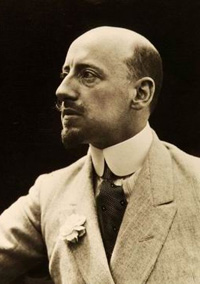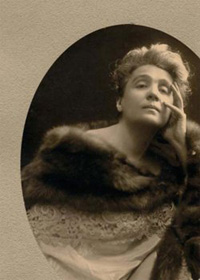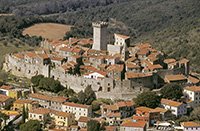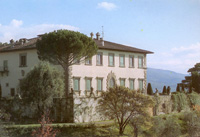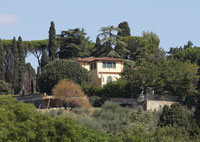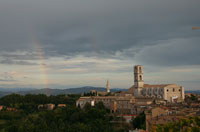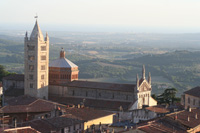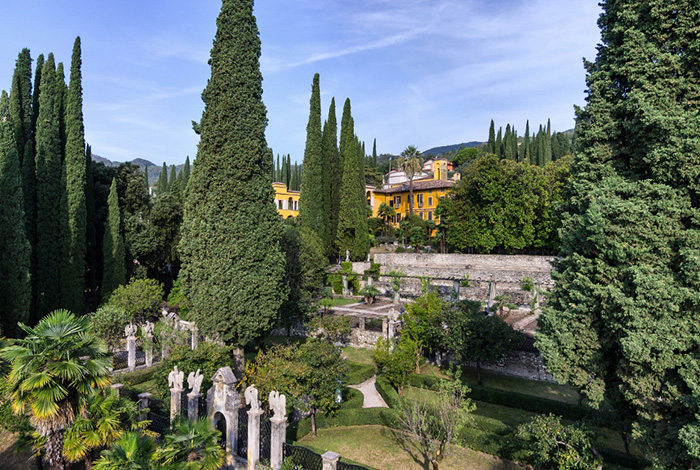 |
| Villa della Capponcina (photograph by Giulio Monasta)
|
Vittoriale degli italiani |
The Vittoriale degli italiani (English translation: The shrine of Italian victories) is a hillside estate in the town of Gardone Riviera overlooking the Garda lake in province of Brescia, Lombardy. It is where the Italian writer Gabriele d'Annunzio lived after his defenestration in 1922 until his death in 1938. The estate consists of the residence of d'Annunzio called the Prioria (priory), an amphitheatre, the light cruiser Puglia set into a hillside, a boathouse containing the MAS vessel used by D'Annunzio in 1918 and a circular mausoleum. Its grounds are now part of the Grandi Giardini Italiani. History
|
| Gabriele D’Annunzio was an Italian poet, novelist and dramatist, military hero, and a typical Latin lover. D'Annunzio combined in his work naturalism, symbolism, and erotic images, becoming the best interpreter of European Decadence in post-Risorgimento Italy. A man of remarkable energy and continuous enthusiasm, D'Annunzio gained fame for leading a flight mission of eight aircraft over Vienna in August 1918 dropping leaflets aimed at demoralising the Viennese population. His heroic adventures during World War I, his love affairs, relationship with the world-famous actress Eleanora Duse, and his occupation of Fiume made him a legend in his own time. Annoyed that Italy had lost the town of Fiume, D´Annunzio's troops occupied the contested port in 1919. As a writer, he was known for L'innocente (1976), Cabiria (1914) and La crociata degli innocenti (1917). L'innocente was the last film made by Italian director Luchino Visconti.[4] D’Annunzio was married to Maria Hardouin di Gallese, a duke's daughter. They had three sons; the marriage ended in 1891. His unfaithfulness drove her to attempt suicide – she threwn herself from the window of their apartment. A new source of inspiration, in the form of Elvira Natalia Fraternali, came to D'Annunzio's life. Known better as Barbara Leoni, she appeared under the pseudonym Vittoria Doni in Elegie romane (1892), written during their love affair. D'Annunzio's best-known novel, The Triumph of Death, Barbara Leoni served as the model for the character Ippolita Sanzio, the mistress of the hero, a writer obsessed with death. In the early 1890s D'Annunzio moved to Naples, where his novel, The Intruder, was serialized in Il corriere di Napoli. In 1894, after a long liaison with the Countess Gravina Auguissola, Gabriele D’Annunzio managed to seduce his final conquest, actress Eleonora Duse. Their relationship started after D'Annunzio's journey to the Aegean islands. Duse read D’Annunzio’s novel L’Innocente and worked to convince him to write a play for her. Inspired by Duse, he wrote several dramas for her, including La Gioconda (1899) and Francesca da Rimini (1901), which along with Ibsen’s dramas she performed all over the world. When not touring, Eleanora Duse lived in a modest villa, La Porziuncola, Via della Capponcina 75, in Settignano, in the hills above Florence. D’Annunzio rented the beautifull villa La Capponcina, living there with his 38 borzoi dogs, 10 horses, 15 servants, and 200 doves.'[3] From 1922 until his death in 1938, D’Annunzio lived a kind of posthumous existence at Il Vittoriale, the villa above Lake Garda that he gradually transformed into a monument and a museum to himself. His work influenced many other writers, including James Joyce. James Joyce called d'Annunzio one of the three "most naturally talented writers" of the late 19th century (the other two were Rudyard Kipling and Leo Tolstoy).
|
||
Buildings at the Vittoriale degli italiani The Prioria
The Relic room holds a large collection of religious statues and images of different beliefs, purposely placed together to make a statement about the universal character of spirituality. The inscription on the inner wall reads: The Amphitheatre The Mausoleum The Light cruiser Puglia |
||
|
||||
Podere Santa Pia, a formal cloister in the Tuscan Maremma with a view made in heaven is situated on the outskirts of Castiglioncello Bandini. Tuscan Holiday houses | Podere Santa Pia |
||||
Podere Santa Pia |
Podere Santa Pia, view from the garden on the valley below |
Capalbio | ||
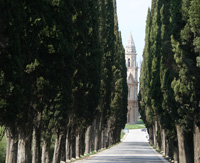 |
||||
Villa Gamberaia |
San Biagio, Montepulciano | Villa Cappuncina in Settignano, Fiesole |
||
 |
||||
Perugia |
Massa Marittima |
Siena, duomo |
||
| This article incorporates material from the Wikipedia article Vittoriale degli italiani, published under the GNU Free Documentation License. Wikimedia Commons has media related to: Gabriele d'Annunzio.and Vittoriale degli italiani. |
||||

